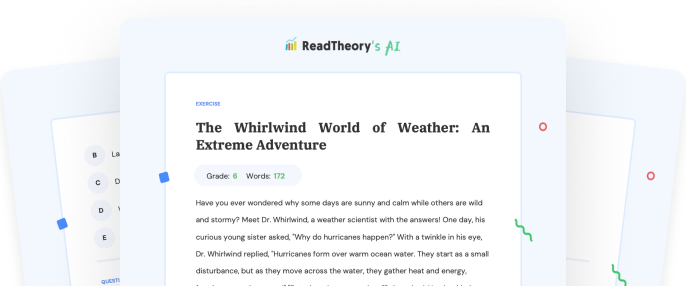Transform Your Teaching
with AI-Powered Worksheets
With ReadTheory’s Instant Worksheet Builder, you can create engaging, grade-appropriate worksheets tailored to your students in minutes. Spark curiosity, save time, and empower critical thinking with AI-powered tools designed for teachers like you.


The Journey of a Plastic Bottle: Understanding Plastic Pollution
In a bustling city, a plastic water bottle begins its journey. Produced in a factory, filled with water, sealed, and sent off to supermarkets. An individual buys the bottle, drinks the water, and discards the empty bottle. This simple act, carried out millions of times daily, significantly contributes to the looming plastic pollution crisis. This bottle, along with countless others, can end up in landfills or oceans, taking hundreds of years to decompose. As it deteriorates, it releases harmful chemicals that pollute the soil and water, thereby posing a threat to our health and the environment. This daunting problem of plastic pollution, however, can be tackled if we choose to make a difference. By consciously deciding to reduce, reuse, and recycle plastic goods, we all can become part of a global movement towards a healthier, cleaner planet.
Question 1
What is the main problem discussed in the text?
Factory production
Ocean pollution
Plastic pollution
Water scarcity
Supermarket supply
Question 2
What does the term 'decompose' mean in this context?
To split into smaller parts
To be consumed by animals
To evaporate
To be recycled
To break down naturally
Question 3
Which of the following is not a suggested solution to the problem?
Reducing the use of plastic
Recycling plastic goods
Reusing plastic goods
Increasing the production of plastic
Joining a global movement
Question 4
What are the harmful effects of plastic decomposition mentioned in the text?
It makes the soil fertile
It increases air pollution
It releases harmful chemicals
It contributes to global warming
It makes the water taste bad
Question 5
What is the author's purpose in writing this text?
To sell plastic water bottles
To discourage the use of water
To promote recycling and conscious use of plastic
To advertise for a supermarket
To discuss the production process of plastic water bottles
 or share via
or share via

Assign the ReadTheory pretest to determine students' reading levels.

Why Teachers Love
Instant Worksheet Builder?

Tailored Content for Every Student
Craft worksheets with passages and multiple-choice questions customized to your chosen topic and grade level, ensuring relevance and engagement.

Save Hours
of Prep Time
Our AI, Lexi, generates complete worksheets—passages, questions, and answers—in minutes, freeing you to focus on teaching, not planning.

Standards-Aligned Learning
Every worksheet is designed to boost reading comprehension and critical thinking, aligning seamlessly with State Standards to help your students shine.
Personalized teaching
for personalized learning
Browse worksheets created and refined by educators using Lexi—your source for inspiration and ready-to-use resources.


ReadTheory is free for Teachers to use.
Join thousands of educators using ReadTheory for free. Sign up today and start creating in just minutes!





